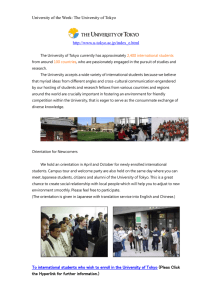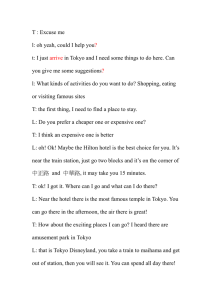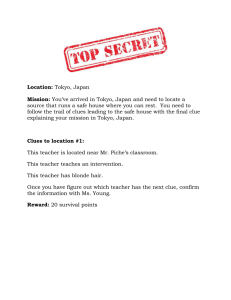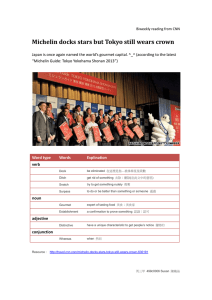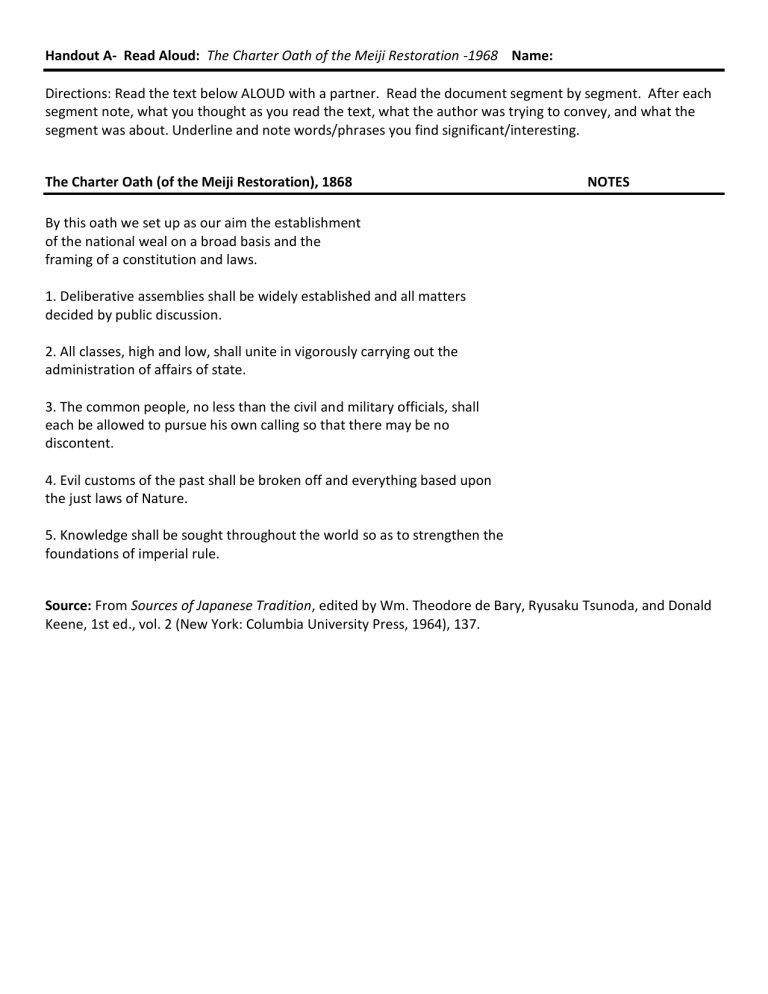
Handout A- Read Aloud: The Charter Oath of the Meiji Restoration -1968 Name: Directions: Read the text below ALOUD with a partner. Read the document segment by segment. After each segment note, what you thought as you read the text, what the author was trying to convey, and what the segment was about. Underline and note words/phrases you find significant/interesting. The Charter Oath (of the Meiji Restoration), 1868 NOTES By this oath we set up as our aim the establishment of the national weal on a broad basis and the framing of a constitution and laws. 1. Deliberative assemblies shall be widely established and all matters decided by public discussion. 2. All classes, high and low, shall unite in vigorously carrying out the administration of affairs of state. 3. The common people, no less than the civil and military officials, shall each be allowed to pursue his own calling so that there may be no discontent. 4. Evil customs of the past shall be broken off and everything based upon the just laws of Nature. 5. Knowledge shall be sought throughout the world so as to strengthen the foundations of imperial rule. Source: From Sources of Japanese Tradition, edited by Wm. Theodore de Bary, Ryusaku Tsunoda, and Donald Keene, 1st ed., vol. 2 (New York: Columbia University Press, 1964), 137. Handout B - Primary Documents: Industrialization in Japan Name partner Directions: Read each primary source section below ALOUD with your pod. Read the document segment by segment. . Underline and note words/phrases you find significant/interesting. Underline the Modernizations that occurred in Japan and how they industrialized. Okuma: from Fifty Years of New Japan, 1907-08 NOTES By comparing the Japan of fifty years ago with the Japan of today, it will be seen that she has gained considerably in the extent of her territory, as well as in her population, which now numbers nearly fifty million. Her government has become constitutional not only in name, but in fact, and her national education has attained to a high degree of excellence. In commerce and industry, the emblems of peace, she has also made rapid strides, until her import and export trades together amounted in 1907 to the enormous sum of 926,000,000 yen. Her general progress, during the short space of half a century, has been so sudden and swift that it presents a rare spectacle in the history of the world. This leap forward is the result of the stimulus which the country received on coming into contact with the civilization of Europe and America, and may well, in its broad sense, be regarded as a boon conferred by foreign intercourse. Foreign intercourse it was that animated the national consciousness of our people, who under the feudal system lived localized and disunited, and foreign intercourse it is that has enabled Japan to stand up as a world power. We possess today a powerful army and navy, but it was after Western models that we laid their foundations by establishing a system of conscription in pursuance of the principle "all our sons are soldiers," by promoting military education, and by encouraging the manufacture of arms and the art of shipbuilding. We have reorganized the systems of central and local administration, and effected reforms in the educational system of the empire. All this is nothing but the result of adopting the superior features of Western institutions. That Japan has been enabled to do so is a boon conferred on her by foreign intercourse, and it may be said that the nation has succeeded in this grand metamorphosis through the promptings and the influence of foreign civilization. For twenty centuries the nation has drunk freely of the civilizations of Korea, China, and India, being always open to the different influences impressed on her in succession. Yet we remain politically unaltered under one Imperial House and sovereign, that has descended in an unbroken line for a length of time absolutely unexampled in the world. We have welcomed Occidental civilization while preserving their old Oriental civilization. They have attached great importance to Bushido, and at the same time held in the highest respect the spirit of charity and humanity. They have ever made a point of choosing the middle course in everything, and have aimed at being always wellbalanced. We are conservative simultaneously with being progressive; we are aristocratic and at the same time democratic; we are individualistic while also being socialistic. In these respects we may be said to somewhat resemble the AngloSaxon race. Source:From: Okuma, Fifty Years of New Japan (Kaikoku Gojunen Shi), 2d Ed., (London: Smith, Elder, 1910), passim.Scanned by: J. S. Arkenberg, Dept. of History, Cal. State Fullerton. Prof. Arkenberg has modernized the text. Handout C: Woodblock Haiku Analysis Image B C D E F G H I J K Examples of Modernization and Industrialization depicted in the Print Name Haiku for the Woodblock Print Examples of 5 syllables traditional Japanese 7 Syllables culture depicted in the Print 5 Syllables EES Image B Background: This is a top and bottom work showing the rail line and the area of Ginza that were characteristic of civilization and enlightenment. The upper painting depicts a steam locomotive departing the Shinbashi station platform for Yokohama and the lower painting, by the fact that the Matsuda restaurant can be seen, depicts a street in Ginza 1-chome. Source: Illustration of the Prosperity of Ginza, Tokyo's Brick Masonry / Illustration of a Shinbashi Railway Steam Locomotive Painted by Utagawa Kuniteru II 1873 (Meiji 6) Tokyo Shiryō 0422-C35 Image C Background: On September 1, 1923 two minutes before noon, a devastating earthquake hit the densely populated area of Tokyo and Yokohama. The shocks reached peaks of 7.9 on the Richter scale. The damages caused by the fires that immediately broke out and raged for three days, were by far worse than those caused by the earthquake itself. When the first shocks hit, many charcoal cooking stoves were in use for the preparation of the lunch meal. And light to strong winds made the fires spread within a few minutes in Tokyo and Yokohama. Image D- Battleship Preparation, 1907 Source: Battleship Preparation, 1907 [2002.5229] Leonard A. Lauder Massachusetts Institute of Technology © 2008 Visualizing Cultures Image E- Steam train between Tokyo and Yokohama Source: "Steam train between Tokyo and Yokohama" by Utagawa Hiroshige III, 1875 [2000.549] Massachusetts Institute of Technology © 2008 Visualizing Cultures Image F - True View of Prosperity: Roundtrip River Steamship Service of the Ryōgok Transportation Company Source: "True View of Prosperity: Roundtrip River Steamship Service of the Ryōgok Transportation Company" by Utagawa Shigekiyo, 1877 [2000.528a-c] Massachusetts Institute of Technology © 2008 Visualizing Cultures Image G- Illustration of the Silk Reeling Machine at the Japanese National Industrial Expositio Source: “Illustration of the Silk Reeling Machine at the Japanese National Industrial Exposition” by Utagawa Kuniaki II, October 1877 [2000.515a-c] Massachusetts Institute of Technology © 2008 Visualizing Cultures Image H- Picture of Azuma Bridge and a Distant View of a Torpedo Explosion Source: “Famous Places in Tokyo: Picture of Azuma Bridge and a Distant View of a Torpedo Explosion” by Inoue Tankei, July 1888 [2000.395] Massachusetts Institute of Technology © 2008 Visualizing Cultures Image I- Roundtrip River Steamship Service of the Ryōgok Transportation Company Source: "True View of Prosperity: Roundtrip River Steamship Service of the Ryōgok Transportation Company" by Utagawa Shigekiyo, 1877 [2000.528a-c] Massachusetts Institute of Technology © 2008 Visualizing Cultures Image K- Post Office at Edobashi Source: “Famous Places in Tokyo: True Vie w of the Post Office at Edobashi” by Kobayashi Ikuhide, 1889 [2000.509] Massachusetts Institute of Technology © 2008 Visualizing Cultures
